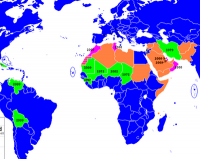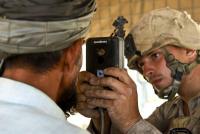-
Germany to put a Syrian refugee on trial for war crimes

A Syrian national who arrived in Germany as a refugee has been arrested and charged with war crimes in his home country. The man is accused of leading a 150-strong armed militia which tortured civilians, kidnapped others for ransom, and enriched itself by selling looted art.
-
-
Terrorists may have entered Europe hiding among asylum-seekers: EU border police

Frontex, the EU’s border police, has said that terrorists may have entered Europe by hiding among asylum seekers. Frontex noted that two of the bombers in last November’s Paris attacks made it to the continent in a smuggling boat from Turkey. “As the vast majority of migrants arrive undocumented, screening activities are essential to properly verify their declaration of nationality,” the report says.
-
-
The real cost of CBP’s failed SBInet is $1.389 billion
Since its approval by Congress in 2006, the exact cost to taxpayers of the Secure Border Initiative network (SBInet) has remained difficult to substantiate. The real cost to date of the failed SBInet program , a cost which excludes the SBInet impact upon both federal agents, border residents, and border crossers, far exceeds the commonly used estimate of $1 billion. The quality, utility, and efficiency of CBP’s failed SBInet program should be judged, like any other federal program, by its real cost to the public. According to government data, that cost to date is $1.389 billion.
-
-
Fixing failed SBInet: Contract delays, quality issues at CBP
Since DHS secretary Janet Napolitano in 2011 cancelled the failed SBInet program, CBP’s Office of Technology Innovation and Acquisition (OTIA) has awarded defense contractors approximately $186,000,000 to replace it. Mark Borkowski’s Office of Technology Innovation and Acquisition (OTIA) has created problems which directly impacting safety and productivity of Border Patrol agents: The needlessly delayed Integrated Fixed Towers (IFT) project has once again placed Border Patrol agents in harm’s way because the men and women who risk their lives patrolling the line still do not possess sophisticated surveillance technology to fight the drug cartels, human traffickers, and potential terrorists crossing our international borders.
-
-
Brazil-Israel stand-off over embassy appointment; teaching German to children refugees

Israel’s outgoing ambassador to Brazil, Reda Mansour, has completed his tour in Brasilia last week and returned to Israel. Brazil, however, is unwilling to accept his replacement — Dani Dayan, a former head of the Jewish settlement council in the Palestinian territories who lives in the occupied West Bank; Germany is in the process of recruiting 8,500 teachers to teach German to children of refugees. The German government estimates that about 196,000 refugee children will enter the German school system this year.
-
-
New biometric measures to identify, track refugees

Refugees applying to come to the United States go through several different security measures aiming to make sure that they who they say they are, and that they are involved with terror organizations or criminal gangs. The security screening includes detailed interviews, three levels of background checks, three fingerprint screenings, contagious disease screening, and cultural orientation. The United States has plans in the works for additional biometric measures, including iris scanning and rapid-turnaround DNA testing.
-
-
CBP begins biometric entry/exit testing at Otay Mesa port of entry

U.S. Customs and Border Protection (CBP) will begin testing new biometric technology at the Otay Mesa pedestrian crossing this week to enhance identification of certain non-U.S. citizens entering and exiting the United States. CBP says its Entry/Exit strategy includes three core pillars: identify and close the biographic gaps and enhance the entry-exit system; perform targeted biometric operations; and transform the entry/exit process through the use of emerging biometric technologies.
-
-
CBP detains 8 Syrians trying to cross Texas border illegally
Eight Syrians have been detained by U.S. Customs and Border Patrol (CBP) agents as they tried to enter the United States from Texas in the Laredo Sector. DHS issued a statement confirming that two Syrian families were taken into custody Tuesday, but clarified that they families were not trying to “sneak in.” A Syrian did attempt to enter the United States illegally through Texas in late September. The Syrian was found to be using a passport that belonged to someone else, and U.S. authorities decided against prosecuting anyone involved owing to “circumstances.”
-
-
How many times does CBP’s Mark Borkowski get to fail?
Once again Mark Borkowski has testified before Congress in recent months, detailing the status of the Arizona Technology Plan, or what he calls the “Plan.” According to Borkowski’s testimony, new border wall surveillance infrastructure and technology are already failing to meet management deadlines; he also acknowledges a highly critical GAO report on the status of his newest border security plan. The Plan is the lynchpin of the Southern Border and Approaches Campaign – previously called the Secure Border Initiative Network (SBInet). SBInet never worked and fell hopelessly behind schedule, and in 2011 DHS Secretary Janet Napolitano pulled the plug on it. SBInet was preceded by other costly border-security technology failure – for example, the Intelligent Computer-Aided Detection system (ICAD11 and ICAD 111), the Integrated Surveillance Intelligence System (ISIS), the American Shield Initiative (ASI),the Secure Border Initiative Tactical Initiative (SBI TI), and Project 28. Despite these failures, the CBP has not constructed a reasonable way in which to measure the success or failure of its new $1 billion dollar Plan. How many times does CBP’s Borkowski get to fail?
-
-
Israel to build sophisticated fencing system along border with Jordan to keep ISIS out
Israel’s cabinet has approved the construction of a new high-tech fencing along Israel’s border with Jordan, with the aim of making it more difficult for Islamist terrorists such as members of ISIS from entering the country. Israel has built sophisticated fencing – indeed, complex defensive systems — along its borders with Lebanon, the West Bank, the Gaza Strip, and Sinai. A similar system has been built along parts of Israel’s border with Syria. The Israeli security services are worried that a route through Jordan, the border with which is not as tightly secured as Israel’s borders with its other neighbors, may be an entryway for its enemies.
-
-
New technologies developed to deal with growing illegal migration
Mass migration driven by climate change is pushing the global demand for border security solutions. It is not just that climate change displaces people through floods, storms, and rising sea levels; it also displaces them through scarcity of food and water, and by the conflicts that are in turn sparked by scarcity and migration. Companies specializing in border solutions are developing new technologies to help border agents track and identify illegal migrants.
-
-
DHS S&T completes Virtua Shooter robotic device, delivers it to ICE
The U.S. Department of Homeland Security (DHS) Science and Technology Directorate (S&T) the other day announced the successful completion of a robotic device that tests multiple types of handguns and ammunition. U.S. Immigration and Customs Enforcement (ICE) agents will use the device to supplement manual testing of the weapons by laboratory staff.
-
-
More money, different approach offer opportunities to border security tech companies
The number of border agents has reached roughly 21,000, up from 5,000 two decades ago. In fiscal year 2012, spending for border and immigration enforcement totaled almost $18 billion — 24 percent more than the combined budgets of the FBI, the DEA, the Secret Service, the U.S. Marshals, and the Bureau of Alcohol, Tobacco, Firearms and Explosives (total: $14.4 billion). One major trend driving the border security industry is the government’s shift from large-scale border security infrastructure projects to small unit security systems.
-
-
Lawmakers want more attention to be paid to security along the northern border
Over the years, concerns over U.S. border security have largely focused on the southern border, where hundreds of thousands of illegal migrants have been apprehended and millions of dollars in illegal drugs have been seized by border patrol agents. One reason for the inattention to the northern border is that it is not associated with highly charged issues such as immigration, day laborers, and violent drug traffickers.Scotty Greenwood, a senior adviser to the Canadian-American Business Council, is not surprised that the southern border gets more attention than the northern border. “The political theater isn’t as intense when you’re talking about what a good job we do.”
-
-
Drug cartels, terrorists may cooperate in smuggling materials for a nuclear device into U.S.
Detonating a nuclear device or dirty bomb in the United States has long been goal of terrorists groups including al-Qaeda. Doing so, however, would require access to nuclear materials and a way to smuggle them into the country. Experts note the nexus between drug organizations, crime groups, and violent extremists and the trafficking of radiological and nuclear materials. A new report points out that al-Qaeda, Hezbollah, and Colombia’s FARC are the three organizations with the motivation and capability to obtain a radiological or nuclear device.
-
- All
- Regional
- Water
- Biometrics
- Borders/Immig
- Business
- Cybersecurity
- Detection
- Disasters
- Government
- Infrastructure
- International
- Public health
- Public Safety
- Communication interoperabillity
- Emergency services
- Emergency medical services
- Fire
- First response
- IEDs
- Law Enforcement
- Law Enforcement Technology
- Military technology
- Nonlethal weapons
- Nuclear weapons
- Personal protection equipment
- Police
- Notification /alert systems
- Situational awareness
- Weapons systems
- Sci-Tech
- Sector Reports
- Surveillance
- Transportation
Advertising & Marketing: advertise@newswirepubs.com
Editorial: editor@newswirepubs.com
General: info@newswirepubs.com
2010-2011 © News Wire Publications, LLC News Wire Publications, LLC
220 Old Country Road | Suite 200 | Mineola | New York | 11501
Permissions and Policies
Editorial: editor@newswirepubs.com
General: info@newswirepubs.com
2010-2011 © News Wire Publications, LLC News Wire Publications, LLC
220 Old Country Road | Suite 200 | Mineola | New York | 11501
Permissions and Policies
